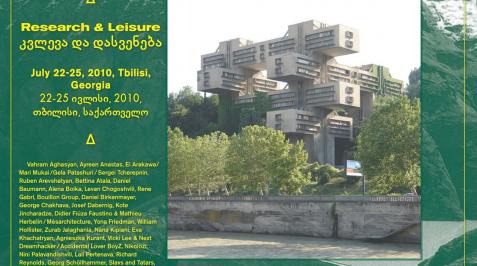The Former Ministry of Highways of Georgian Soviet Socialist Republic
A project by Joanna Warsza
On-site talks curator: Eva Khachatryan
Artists, academics, architects, curators, economists, and residents of Tbilisi in a context-responsive summer art project in the time between the former Ministry of Highways of the Soviet Republic of Georgia and the future headquarters of the Bank of Georgia:
Vahram Aghasyan, Ayreen Anastas, Ei Arakawa, Ruben Arevshatyan, Bettina Atala, Daniel Baumann, Alena Boika, Rene Gabri, Bouillon Group, Daniel Birkenmayer, George Chakhava, Josef Dabernig, Kote Jincharadze, Didier Fiuza Faustino & Mathieu Herbelin / Mésarchitecture, Yona Friedman, William Hollister, Zurab Jalaghania, Nana Kipiani, Eva Khachatryan, Agnieszka Kurant, Nikoloz Lutidze, Nini Palavandishvili, Gela Patashuri, Lali Pertenava, Richard Reynolds, Georg Schöllhammer, Slavs and Tatars, Sophia Tabatadze, Nienke Terpsma & Rob Hamelijnck / Fucking Good Art, Wato Tsereteli, Urban Research Lab: Gio Sumbadze, Ani Chorgolashivili & Rezo Glonti, Greg Lindquist, Tamuna Karumidze, Neli Zedgenidze & Koka Ramishvili; Urban Reactor, Jan Verwoert & Melinda Braathen, Vladimir Volnovik, Aleksandra Wasilkowska, Martin Zet
The Caucasus speaks with frozen moments. With the fall of the Communist regime, trains stopped mid-route, the cable car over one of the canyons of Tbilisi was abandoned halfway, and the housing estates of the never realized future in Mush found temporary settlers. The heritage of Soviet architecture in the region has revealed its anticipatory potential of multiple secondary uses, creative economies, and the sustainable and self-organizing policies parallelly present in the cultural discourse nowadays. The Former Ministry of Highways of the Soviet Republic of Georgia, erected in 1975 by architects George Chakhava (1923–2007) and Zurab Jalaghania is one of the most stunning buildings in the world. An example of a realized utopia (a utopie réalisable), it has been productive of an augmented reality, blending the image of the future under Communism with organic, palimpsestic architecture and the concepts of a continuous, non-master-planned environment.
Sponsored by The Ministry of Culture of the Republic of Poland the City of Warsaw, in collaboration with the City of Tbilisi, Transkaukazja, with the support of the Culture Programme of the European Union
Main Partner: Bank of Georgia










